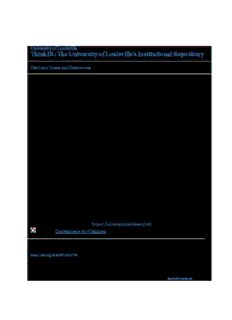
Transversal approaches and ecological artwork. PDF
Preview Transversal approaches and ecological artwork.
UUnniivveerrssiittyy ooff LLoouuiissvviillllee TThhiinnkkIIRR:: TThhee UUnniivveerrssiittyy ooff LLoouuiissvviillllee''ss IInnssttiittuuttiioonnaall RReeppoossiittoorryy Electronic Theses and Dissertations 5-2017 TTrraannssvveerrssaall aapppprrooaacchheess aanndd eeccoollooggiiccaall aarrttwwoorrkk.. Madison DeAnna Sevilla University of Louisville Follow this and additional works at: https://ir.library.louisville.edu/etd Part of the Contemporary Art Commons RReeccoommmmeennddeedd CCiittaattiioonn Sevilla, Madison DeAnna, "Transversal approaches and ecological artwork." (2017). Electronic Theses and Dissertations. Paper 2722. https://doi.org/10.18297/etd/2722 This Master's Thesis is brought to you for free and open access by ThinkIR: The University of Louisville's Institutional Repository. It has been accepted for inclusion in Electronic Theses and Dissertations by an authorized administrator of ThinkIR: The University of Louisville's Institutional Repository. This title appears here courtesy of the author, who has retained all other copyrights. For more information, please contact [email protected]. TRANSVERSAL APPROACHES AND ECOLOGICAL ARTWORK By Madison DeAnna Sevilla B.S. Appalachian State University, 2015 A Thesis Submitted to the Faculty of the College of Arts and Sciences of the University of Louisville in Partial Fulfillment of the Requirements for the Degree of Master of Arts in Art(c) and Art History Critical and Curatorial Studies Hite Art Institute Department of Fine Arts University of Louisville Louisville, Kentucky May 2017 TRANSVERSAL APPROACHES AND ECOLOGICAL ARTWORK By Madison DeAnna Sevilla B.S. Appalachian State University, 2015 A Thesis Approved on April 17, 2017 by the following Thesis Committee: _____________________________ Thesis Advisor Chris Reitz _____________________________ Christopher Fulton _____________________________ Mehmed Kantardzic ii DEDICATION This thesis is dedicated to all four of my parents who have continually loved and supported me in every way imaginable. My kindness, patience, work ethic, and sense of humor are a direct result of your teachings. I would not be the woman that I am today without you. I also want to thank my sisters and my love. You will never regain the time spent listening to my rants—I am forever grateful. iii ACKNOWLEDGEMENTS To Dr. Chris Reitz, Dr. Christopher Fulton, and Dr. Mehmed Kantardzic—thank you for your guidance and your immense patience during this process. I am grateful for your valuable feedback and direction. iv ABSTRACT TRANSVERSAL APPROACHES AND ECOLOGICAL ARTWORK Madison DeAnna Sevilla April 17, 2017 This work explores systematic ecology as it relates to sculpture and language. This project exists in two parts: a written thesis and a thesis exhibition. Although both works explore ecological systems, Unseen: Visualizing Ecological Systems investigates visualizations and concepts of the ecological, whereas this thesis continues the exploration into the ramifications of disruptions in systems. Ecological systems such as the environmental, social/mental, economic, and political define the foundations of our known world and encapsulate all regions of society. No single system can function independently of the rest and all systems contain some aspect of human- system involvement. By using the work of environmental and conceptual artists, this thesis studies the limits of systems and examines artwork that seeks to reveal and conceal unrecognized human interaction. In the following chapters, I will examine the work of these artists through an ecological mindset as laid out by philosophers and theorists to showcase the varying degrees of ecological efficacy. v TABLE OF CONTENTS PAGE ACKNOWLEDGEMENTS…………………………………………………………………..iv ABSTRACT………………………………………………………………………….………..v LIST OF TABLES…………………………………………………………………….……..vii LIST OF FIGURES…………………………………………………………………...…….viii INTRODUCTION…………………………………………………………………………….1 CHAPTER I: INTRODUCTION TO ECOLOGY AND TRANSVERSAL APPROACHES………………………………………………………………………….……3 CHAPTER II: INEXTRICABILITY OF HUMAN INVOLVEMENT………………...........18 Imaginary Landscapes……………………………………………………………….19 Closed Systems…….………………………………………………………………...25 Impact of the Viewer…………………………………….…………………………..29 Redefining Space………………...…………………………………………………..32 Questioning Value Systems…………………………...……………………………..34 Interdisciplinary Criticality..………………………………………………...……….37 CHAPTER III: THE REFERENCE OF RUBBLE………………………….….........………39 CHAPTER IV: UNSEEN: VISUALIZING ECOLOGICAL SYSTEMS …...……...……...…..53 CONCLUSION: SEPARATION BETWEEN REPRESENTATION AND FORM…..…….75 REFERENCES………………………………………………………………………………77 APPENDICES……………………………………………………………………………….79 CURRICULUM VITA……………………………………………………………………....89 vi LIST OF TABLES TABLE PAGE 1. Budget for Unseen: Visualizing Ecological Systems…………………….………………..79 2. Checklist for Unseen: Visualizing Ecological Systems…………………….……….…….80 vii LIST OF FIGURES FIGURES PAGE 1. Lieko Shiga. Rasen Kaigan (Spiral Shore) (2011)……………………………..…………..6 2. Hans Haacke. Condensation Cube (1965) ……….……………………………………….10 3. Hans Haacke. Grass Grows (1967-1969) ………….……………………………………..12 4. Hans Haacke. Rhinewater Purification Plant (1972) ……………….……………………14 5. Alan Sonfist. Time Landscape (1965-present) ………………………………..………..…21 6. Bernini. Vision of Constantine (1670)…………………………………….…..…………..23 7. Helen and Newton Harrison. Survival Pieces (1971-1973)……………………………….26 8. Helen and Newton Harrison. Survival Piece #3: Portable Fish Farm (1971) .…………..28 9. John Lifton. Green Music (1976)………….………………………………………………31 10. Michael Rakowitz. (P)LOT (2004-present) ……………………………………………..33 11. Tue Greenfort. Diffuse Einträge (2007) …………………………………………………36 12. Iain Baxter. Portfolio of Piles (1968) …………………………………………………...42 13. Robert Smithson. Rock Salt and Mirror Square I (1969) ……...………………………..44 14. Robert Smithson. (Essen Soil and Mirrors) (1969) …………………………...………...48 15. Robert Smithson. Nonsite (Franklin, New Jersey) (1968) ……………………...……….51 16. Stephen Cartwright. Human Powered Outdoor Activity and Temperature 2014-2015 (2016)…………………………………………………………………………………….......56 17. Stephen Cartwright. Human Powered Outdoor Activity 2014-2015 (2016) ……...……..58 viii
Description: